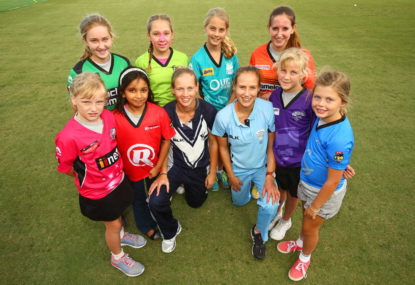No matter who emerges victorious in the first ever Women’s Big Bash League finals, it’s pretty clear that when it comes to the inaugural competition, everyone is already a winner.
The incredible success of the tournament has blown open doors when it comes to the potential for women’s sport in Australia.
» WBBL live stream: how to watch every game of WBBL|02
» WBBL Fixtures: The complete schedule for the second season
» WBBL on The Roar
There’s an argument that tends to arise when women’s sport is discussed, that there’s a reason why it doesn’t get the coverage, sponsorship or support that men’s sports do.
And that no matter how hard we try, gender equality in sport will never happen because people aren’t interested in women’s sport.
The incredible strides that women’s sports have taken in the past year or so give rise to a resounding counter argument that says that argument is nonsense. This summer the Women’s Big Bash League has proven that oft-used axiom: if you build it, they will come.
By ‘it’, I mean build a genuinely professional product, something that doesn’t look out of place next to men’s sport.
That professionalism has to come from all sides: in organisation, TV coverage, promotion, and in the competition itself. With the WBBL, never has a women’s sport ticked so many boxes at once.
Cricket Australia and Channel Ten have gone out of their way to ensure the quality of this tournament.
The teams are linked to existing BBL franchises to attract established fan-bases. Top international and Australian players were recruited, the teams are all competitive and the games have been played at a very high standard. Double headers were scheduled with the BBL so that games could be televised, and to ensure the most professional coverage possible Channel Ten have used the same TV production set up as the BBL.
The camera angles, quality of the commentary, graphics and statistics, player interviews, the kids zones – minus some fireworks and Freddie Flintoff antics – it’s just like watching a men’s Big Bash game. Which is exactly what it needs to be.
Even with all of these things, expectations for the competition were still modest. For Cricket Australia it was a loss leader, sharing the substantial cost of double headers with Channel Ten to get the women on the air, and not charging for entry to stand-alone games to make sure they were played in front of crowds.
For Network Ten it was the cost of doing business with Cricket Australia and the immensely profitable BBL as they aim to compete with Channel Nine in cricket broadcasting. They put the girls on ONEHD and apparently projected that average audiences could be as low as 40,000 per game. It was more a show of good faith from all involved, rather than something that was expected to garner ratings or profits.
And then it began.
The first weekend of games saw crowds of more than 1500 in Melbourne and 1000 in Sydney. The first televised game, Heat versus Strikers on December 18, drew an average of 250,000 viewers on ONE – more than five times Channel Ten’s internal projections.
The next day Sixers versus Scorchers followed up with a 183,000 average audience. In the space of two days the WBBL went from a curious experiment to a TV property that was outdrawing men’s sports as significant as the A-League.
Channel Ten immediately responded by promoting the Melbourne Derby to their main channel, and as the season went on the numbers just got bigger and bigger. Crowds of 10,500 in Adelaide on New Years Eve, 12,901 for the Melbourne Derby, 14,611 for Renegades versus Thunder at Etihad, and 12,220 for Saturday’s Sydney Smash.
The move to Ten proved fruitful as an average of 372,000 tuned into the Stars versus Renegades clash, with a peak audience of 439,000. Attendance and ratings records for women’s cricket were not only being broken, but being annihilated on an almost match-by-match basis.
At the beginning of the season the WBBL semi-finals weren’t even supposed to be televised; they were going to be held at suburban ovals mid-week to probably a couple hundred spectators. Now they have been re-scheduled as double headers, and the girls will fight for a place in the final at the Adelaide Oval and MCG, in front of thousands of fans and on live television.
The final will be broadcast live on Channel Ten on Sunday, and the trickle down effect has already reached beyond the WBBL itself.
The increase in interest in women’s cricket led to the announcement of the Governor-General’s XI match as an annual fixture for the women, and the Southern Stars’ upcoming T20 series versus India will be broadcast on the Nine Network. By next summer, we should have our first generation of bona fide, honest to goodness, fully professional female cricketers.
And other sports have already responded as well: in the new year, the FFA organised to hold extra televised double headers to cover the last two rounds of the regular W-League season. The flow-on effect of this unprecedented interest in female sport could be felt for years to come, and this could truly be a landmark summer for women’s sport in this country.
Without a shadow of a doubt, it is already a landmark summer for women’s cricket.
Of course, we can’t get too far ahead of ourselves just yet, as the long-term viability of the WBBL is still unknown. It remains to be seen whether it can become a stable, profitable entity in its own right, and becoming a profitable entity is the only way to guarantee the future of the WBBL as a professional competition.
But in the short term, we can go ahead and call the inaugural Women’s Big Bash League a resounding, unequivocal success. As it turns out, people will watch women’s sport. If you build it, people will come. Now they just need to keep coming back.





























































































